- Home
- Pat Conroy
The Pat Conroy Cookbook Page 13
The Pat Conroy Cookbook Read online
Page 13
But those images reminded me of something else, and it took me a while to make the connection. They conjured up images of those postcards my grandmother had sent me from around the world that I would study in the privacy of my room: the lionesses of Kenya, the elephants of Tanganyika, the cobras of Bengal. Those postcards, faded and yellow now, were my introduction into the bright world of travel, fantasy, and art. In this perfect letter I would tell my grandmother this.
But no. No, sweet Margaret Stanton, there are no perfect letters to frail and wonderful grandmothers. The gratitude is in the emulation; the joy is always in the voyage, the setting out. You and my grandfather presented me with the wanderer’s gift. I have been true to it; I have not abused it.
And something else: it came to me like a postcard or a painting on a cavern wall. When I heard of your stroke, I thought about living in the world without you and I felt the air grow still and the light change. Then I saw him for the first time and understood at last. I saw your sea monster, kindly and serene, mythic and loving, rise out of the Gulf Stream and swim casually toward the shores of Jacksonville, toward his old friend and traveler. I hope that when he comes, you will be ready with all your bags packed. I hope for you that this last voyage through dreams and seas is the best of all.
When it is my turn, old traveler, after I have directed my grandchildren to some of the fabulous places of the earth that you urged me to visit, send him softly to me. I’ll be easy for any well-traveled beast to recognize.
I’m your grandson.
The grateful one.
The Jasper-blooded one.
RIBOLLITA A Tuscan reboiled minestrone soup that is thickened with bread and made the day before it is to be served. • SERVES 6
8 ounces dried cannellini beans or Great Northern beans
1 slice (about 2 ounces) pancetta or prosciutto
½ cup olive oil
1 large red onion, thinly sliced
2 carrots, scraped and diced
3 celery stalks, diced
1 medium potato, peeled and diced
½ small head savoy cabbage, shredded
1 small bunch Swiss chard, cleaned, trimmed, and roughly chopped
1 cup canned whole tomatoes, preferably San Marzano, broken up into pieces, with their juice
Rind from 1-pound piece Parmigiano-Reggiano, scraped clean, plus freshly grated Parmigiano-Reggiano
6 cups Beef Stock (page 13) or Chicken Stock (page 11)
Coarse or kosher salt and freshly ground black pepper
12 thick slices day-old Tuscan bread
1. Soak the dried beans overnight in a bowl of cold water. The next day, drain the beans, transfer them to a large saucepan, and cover with cold water (the level of the water should rise 2 inches above the beans). Add the pancetta and bring the beans to a boil to partially cook them, about 15 minutes.
2. In a stockpot large enough to hold all the ingredients, heat the olive oil over medium-low heat and cook the onion until pale but not browned. Add the carrots, celery, and potato, stirring a few times and cooking the vegetable mixture until slightly softened, about 15 minutes. Add the cabbage, chard, and tomatoes.
3. Drain the beans and transfer to the stockpot. Add the Parmigiano-Reggiano rind and enough stock to cover the vegetables by about 3 inches. Slowly simmer until the vegetables are soft and the flavors marry about 1 hour. Taste for salt and pepper.
4. Tear large chunks from the bread slices and place in the soup. Bring the soup to a boil for about 1 minute, using a wooden spoon to stir the soup and break up the bread. Cool to room temperature, transfer to a storage container, and refrigerate overnight. (The soup will thicken.)
5. Reheat the soup and ladle into bowls. Sprinkle with grated Parmigiano-Reggiano cheese, passing extra cheese on the side.
BEEFSTEAK FLORENTINE FOR TWO If you are ever lucky enough to find yourself in Tuscany, make sure you order a bistecca alla florentina. The Tuscans raise a breed of cattle called the Chianina that tastes more flavorful than any cow with a Texas accent. At the Villa la Massa outside of Florence, I ordered the bistecca alla florentina while I watched the sunset over the Arno River as a fly fisherman made the sun light lash about on the river. It was a perfect scene and a perfect meal, and eaten with complete joy in a perfect country. • SERVES 2
2 teaspoons coarse or kosher salt
1 teaspoon freshly ground black pepper
1 teaspoon granulated garlic
Olive oil (only enough to moisten the spices)
T-bone or porterhouse steak, approximately 2½ pounds and 2½inches thick
Lemon wedges or balsamic vinegar
1. Mix the spices together and add the olive oil drop by drop until a paste forms. Rub the paste on both sides of the steak. (Use sparingly; excess paste will sit on the surface and make the meat mushy.) Wrap in plastic and refrigerate for at least 2 hours.
2. Light a hot fire in a charcoal grill or preheat a gas grill to medium-high. Place the steak on the grill, cover, and cook until done: 6 to 8 minutes per side for rare, 7 to 9 per side for medium rare.
3. Transfer the steak to a cutting board and let it rest for about 10 minutes to let the natural juices redistribute. Using a knife with a thin sharp blade, cut the meat away from the bone. Carve each section of the steak into thick slices and reassemble around the bone on a serving platter. Serve with lemon wedges or balsamic vinegar for drizzling.
PIZZA BIANCA If the wind was coming off the Campo de’ Fiori when you woke up in Rome, you could smell the pizza bianca coming from the ovens of the bakery at the far side of the Campo, where the flower ladies were arranging lilies and the olive man was moving his cart into position. At the other end of the Campo, the fish were being laid out like playing cards on shaved ice and the garlic man was yelling at an early-bird turista that he was not open for business until he had his caffe and his pizza bianca. The pizza bianca came out of those ovens hot to the touch and you bought it when it could still warm your hands on a cold day. It had no mozzarella on it, no garlic, and no basil. What I remember, though, is salt, and never has salt and dough and yeast tasted better than when I walked down an obscure alleyway near the Campo and partook of that simple Roman pleasure. In Rome the simplest things were always the best. We jazz our recipe up with mozzarella and basil, making it more Neapolitan than Roman. Both are divine.
• MAKES ONE 12-INCH PIZZA
1 package (¼ ounce) dry yeast
½ cup plus ¼ cup warm water
1¾ cups plus 2 tablespoons unbleached all-purpose flour
¾ teaspoon coarse or kosher salt
Several garlic heads
2 tablespoons olive oil
1 pound fresh mozzarella, cut into thin slices
Several fresh basil, leaves torn into thin strips
1. Stir the yeast into the ¼ cup water and let stand for 10 minutes.
2. Mix the flour and salt together. Pour the ½ cup water into the yeast mixture. Add the flour and mix well with a wooden spoon, a food processor, or a standing mixer until the dough comes together and is smooth and elastic. Place the dough in a large bowl, cover with a damp dish towel, and put in a warm place away from drafts. Let the dough rise until doubled in size, about 2 hours. Punch the dough down by turning it out onto the counter and kneading it with the palm of your hand once or twice. Put the dough back in the same bowl and let it rise for another hour. The dough is now ready for shaping.
3. On a lightly floured, clean, dry surface, roll the dough out into a rough circle. Rotate and turn the dough, adding flour if the dough sticks to the work surface. Roll the dough until it is about 12 inches in diameter. (If the dough becomes difficult to roll, let it rest for a few minutes before continuing.)
4. Preheat the oven to 300°F.
5. Separate the garlic cloves and toss them in the olive oil. Place the cloves in a roasting pan and bake until soft and aromatic, about 1 hour. Peel the cloves (the skins should easily slip off) and transfer to a mixing bowl. Smash the cloves with the back
of a wooden spoon to make a paste. Set aside.
6. Adjust the oven temperature to 450°F.
7. Spread the roasted garlic paste over the prepared pizza dough. Cover with slices of fresh mozzarella. Bake in the lower third of the oven (or better still, on the oven floor) for 15 minutes, until the rim is golden and the cheese is lightly browned. Remove from the oven and garnish with strips of fresh basil. Serve hot.
SCOTTIGLIA In Siena, that most mysterious and storied city, with its mélange of oddly named and competitive wards that strive against one another during a horse race called the Palio (one of the wards is called Bruco, “the Caterpillar”), I first tasted the divine Scottiglia. I personally believe that Scottiglia made in Tuscany tastes better than it does anywhere else in the world, but that is only a personal belief.
• SERVES 4 TO 6
3 tablespoons olive oil
2½ pounds beef short ribs (about 5 ribs, cut flanken style)
½ pound pork shoulder, cut into 2-inch cubes
½ pound veal shoulder, cut into 2-inch cubes
One 2½-pound rabbit, cut by your butcher into 6 pieces: front legs, back legs, and split saddle
½ cup diced carrot
½ cup diced celery
3 shallots, coarsely chopped
2 garlic cloves, minced
2 cups red wine
3 cups Chicken Stock (page 11)
1 tablespoon chopped fresh sage
1 tablespoon chopped fresh thyme
1 small dried red chile
1 cup canned whole tomatoes, preferably San Marzano, broken up into small pieces and drained
Coarse or kosher salt and freshly ground black pepper
Grilled Tuscan bread, rubbed with cut garlic cloves
1. Preheat the oven to 375°F.
2. In a large Dutch oven over high heat, heat the oil until hot but not smoking. Brown, remove, and reserve meats separately, in the order listed. Add the carrot and celery to the pot and cook, stirring frequently, until they begin to color on the edges, about 3 minutes (adding more oil sparingly, if necessary). Remove and reserve with the browned rabbit (or whatever meat will be the last addition to the stew).
3. Add the shallots and garlic to the pot and quickly stir to wilt. Add the red wine and stir, letting the liquid bubble up and loosen any browned bits stuck to the bottom of the pot. Adjust the heat slightly lower and add the stock, sage, thyme, chile, and tomatoes. Let simmer for several minutes.
4. Add the beef short ribs, pork, and veal. When the cooking liquid returns to a simmer, cover and immediately transfer pot to the oven for 1 hour. Remove the pot from the oven to add the rabbit, carrot, and celery, then return the pot to the oven until the beef short rib meat is tender and falling off the bone and the rabbit is cooked through, about 45 minutes.
5. Season the stew with salt and pepper and serve over grilled bread.
Timing and cooking method in this Tuscan dish of mixed meat stew (also called cacciucco di carne) vary from kitchen to kitchen depending on the meat used, as well as on whether it is on or off the bone. (The more meat on the bone, the better the stew.)
Brown and reserve the meat separately and add to the stew in order of toughness to tenderness (cooking time required). In this particular version, the short ribs, pork, and veal go first, then the rabbit.
BAKED TOMATOES WITH RICE • SERVES 4
4 medium tomatoes, about ½ pound each
2 tablespoons olive oil
2 shallots, finely chopped
¼ cup finely chopped red bell pepper
2 cups rice cooked in chicken stock
2 tablespoons finely chopped flat-leaf parsley
Coarse or kosher salt and freshly ground black pepper
1. Preheat the oven to 350°F.
2. Lightly oil a baking dish just large enough to hold the tomatoes snugly.
3. Cut off the “cap” (a thin slice) from the top of each tomato and spoon out the pulp (being careful not to tear the walls). Reserve ¾ cup of the pulp and discard remainder or save for another use. Invert the tomatoes on a paper towel–lined baking sheet to drain.
4. In a large skillet, heat the oil over moderate high heat. Add the shallots and red pepper, cooking quickly until the edges begin to color, 2 to 3 minutes. Add the reserved tomato pulp and reduce over medium heat until thickened, 4 to 6 minutes.
5. Stir in the rice and cook until the tomato is absorbed and the flavors marry, about 3 minutes. Sprinkle in the parsley, season with salt and pepper, and remove from the heat.
6. When the mixture has cooled slightly, spoon the rice into the hollowed-out tomatoes and place in prepared baking dish.
7. Bake until heated through, 12 to 15 minutes. Check frequently, as overcooking will cause the tomatoes to split and fall apart. Serve 1 tomato per person.
SPAGHETTI CARBONARA My landlord in Rome, Spiro Rascovic, told me of the widespread starvation throughout the city during World War II before the American army swept in from the south and liberated it. His brother, Savo, was on the brink of dying when Spiro walked out into the piazza as an American jeep entered it by a side street and drove straight toward the group of men with whom Spiro was standing. A striking American named Dan Wickersham stood up and shouted, “Does anyone speak English here?” Spiro’s hand shot up and he said, “I do, sir.” Captain Wickersham motioned for Spiro to get in the jeep.
They drove to headquarters just south of Rome, and when Wickersham led Spiro through a mess tent, Spiro almost fainted at the smell of food. They passed a corporal grilling steaks, and Spiro stopped Captain Wickersham and said, “Please, my brother and I have not eaten for days.” Wickersham grabbed six uncooked steaks and gave them to Spiro, who told me, all those years later, “The great Captain Wickersham saved the life of my brother and me.”
Later, Spiro admitted to me that he rented the house to my family only because I reminded him of the great Dan Wickersham.
Spaghetti Carbonara was born at the same time that Wickersham was liberating Rome. My neighbors at the Piazza Farnese told me that the army of liberation brought eggs and bacon into Roman restaurants and asked the chefs to make them a pasta sauce. The Romans quickly adapted the ingredients into this delicious recipe, and my family often dined at a restaurant near the bakery and the olive man in the Campo de’ Fiori with “Carbonara” in its name. The Romans use pork jowl, but pork jowl is hard to come by in America. I normally use pancetta, but the finest grades of bacon work well.
• SERVES 4 AS A MAIN COURSE OR 6 AS A FIRST COURSE
1 pound thick-sliced bacon, chopped
1 pound spaghetti
4 large eggs
2 teaspoons freshly ground black pepper
1 cup plus 2 tablespons freshly grated Parmigiano-Reggiano or Pecorino
1. In a large heavy skillet over medium heat, cook the chopped bacon until crisp. Remove the bacon and reserve, saving the bacon drippings separately.
2. Cook the spaghetti according to package directions in abundantly salted boiling water. While the spaghetti is cooking, beat the eggs, pepper, and 2 tablespoons cheese together in a bowl.
3. When spaghetti is al dente, drain thoroughly and return to the pot. Toss with about 1 tablespoon of the bacon drippings (all the noodles should be coated).
4. Place the pasta in a warm serving bowl, add the egg mixture, and toss quickly. Add the reserved bacon and 1 cup grated cheese and toss again.
5. Serve at once, passing more cheese and the pepper grinder at the table.
In the early eighties, I brought my family to live in Italy based on an ill-conceived theory I have about the effects of expatriation on writing. I’ve always thought that writers should spend part of their lives testing themselves in the crucibles of alien cultures. As a Southern writer I’ve worried that my prose would smell too much of okra and sweet potatoes, that my vision would begin and end along the drifting, surreal avenues of small Southern towns, and that all my novels would be summed up in the phrase “the night the hogs ate Willie in S
outh Carolina.” For a long time I’ve looked on Europe as a kind of finishing school for writers, a place for me to replenish exhausted metaphors and to refresh my dimming imagination before I sat down to write a new novel. What I didn’t know but learned fast is that living abroad is Europe’s revenge for our ancestors’ migrating to the United States.

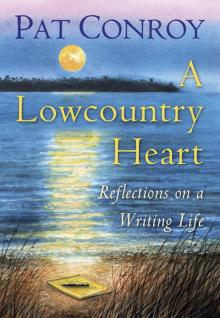 A Lowcountry Heart: Reflections on a Writing Life
A Lowcountry Heart: Reflections on a Writing Life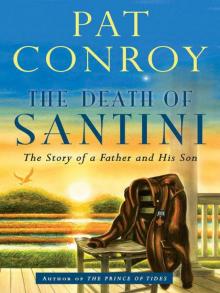 The Death of Santini: The Story of a Father and His Son
The Death of Santini: The Story of a Father and His Son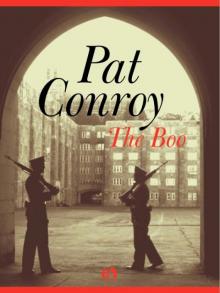 The Boo
The Boo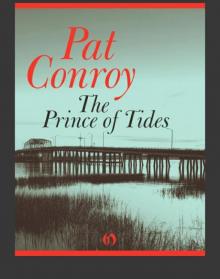 The Prince of Tides
The Prince of Tides Beach Music
Beach Music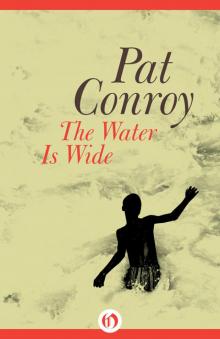 The Water Is Wide
The Water Is Wide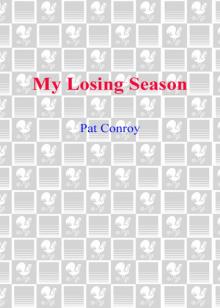 My Losing Season
My Losing Season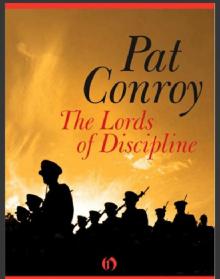 The Lords of Discipline
The Lords of Discipline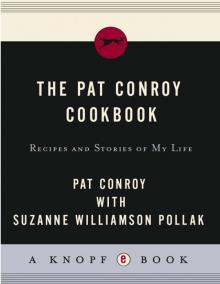 Pat Conroy Cookbook
Pat Conroy Cookbook My Reading Life
My Reading Life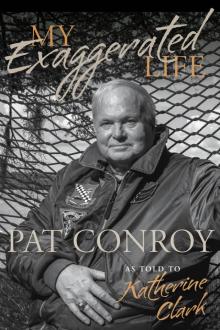 My Exaggerated Life
My Exaggerated Life The Pat Conroy Cookbook
The Pat Conroy Cookbook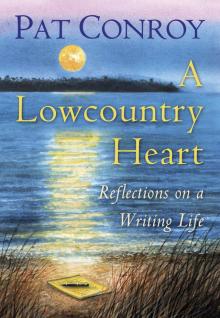 A Lowcountry Heart
A Lowcountry Heart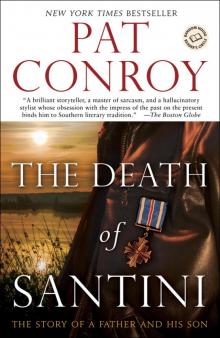 The Death of Santini
The Death of Santini